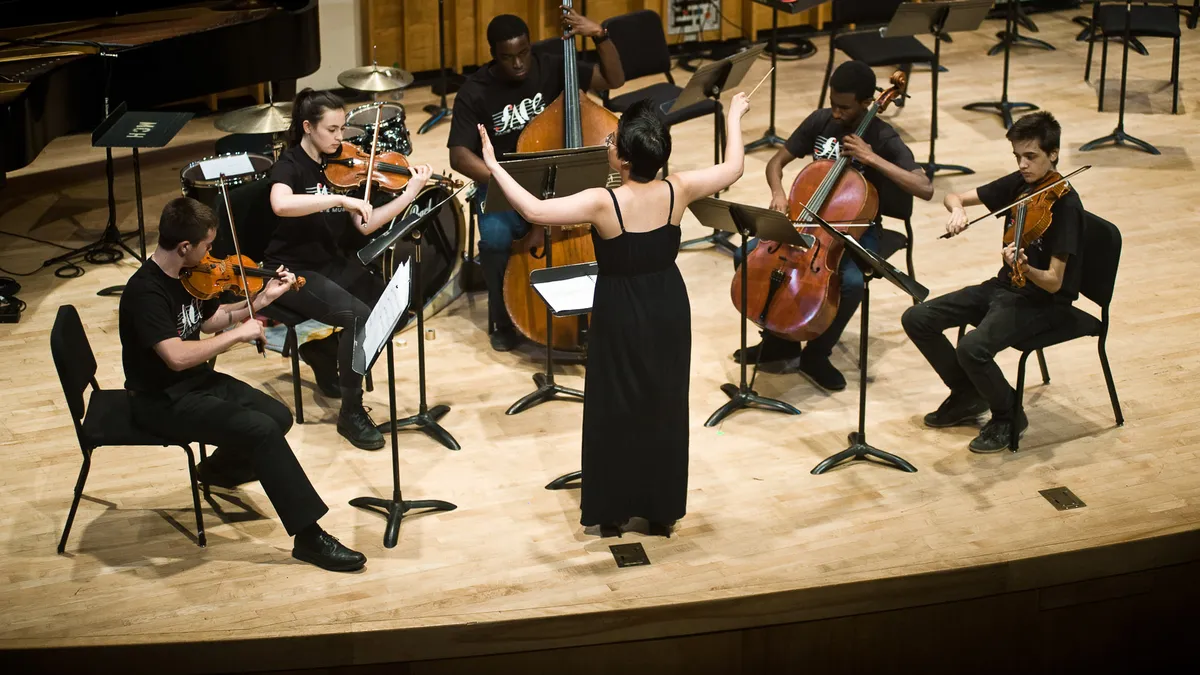Some of New York City’s highest-performing students spend much of their time studying music. These students attend the Special Music School at Kaufman Music Center, a public school founded in 1996 as a public-private partnership.
The New York City Department of Education apportions standard funding for the school based on its own budget and the Kaufman Music Center adds about $8,000 per student to the total, covering an intensive music education that begins in kindergarten, when students are identified as having strong musical potential.
This focus on music doesn’t detract from an emphasis on academics, and the Special Music School’s standardized test scores prove it. SMS students routinely rank among the highest in the city on state math and English language arts exams.
Lydia Kontos, executive director of the Kaufman Music Center, doesn’t think that’s a coincidence. She says music helps students understand deferred gratification, which is becoming increasingly uncommon in children’s lives.
“It’s not so easy to make it disappear in music,” Kontos said. “A child gets a piece to learn, doesn’t know it at all, and works through it with a teacher and masters it. They get that feeling that it doesn’t happen the next day. It could happen the next week; it could happen in the next month.”
Kontos counts this as one of the key learning advantages of music. And she says it provides a good parallel to other academic subjects. Learning a piece of music is something that can be done alone. Practicing a song mirrors the individual effort required to complete math homework or English homework. What’s more, music education, like other core subjects, can start very early and content can be layered on as students develop greater capacity and age through their educational programs.
At the elementary level, the Special Music School has small class sizes of about 15 students, and teachers spend part of the week with only half of their students while the others get one-on-one music lessons. That creates ample time for differentiation and ensures students can get close attention from their teachers in traditional academic subjects, too.
Special Music School at Kaufman Center Principal Katie Banucci-Smith says the rigorous music program teaches students how to read music, listen, respond and collaborate. It creates inquiry-minded students who question, argue and think critically. The focus on music, then, serves as an asset even for traditional metrics for assessing schools.
“That is one of the most profound reasons we score so well,” Banucci-Smith said.
The school, on New York City’s Upper West Side and open to students across all five of the city’s boroughs, is a bit of a unicorn. But Kontos hopes it won’t always be considered “special.”
Schools across the country cut their music programs in response to tight budgets and increasing pressure to perform on standardized tests. Kontos watched as curriculum experts in music left the field or turned their attention to other things. Now there is a dearth of information about designing good programs, even for principals who want to re-start old efforts, she says.
In New York City, Schools Chancellor Carmen Fariña has acknowledged that the disappearance of arts education is a problem. That’s step one. Finding funding to help schools get programs off the ground is step two. And as school leaders consider how to add music to their curricula, Banucci-Smith, encourages them to avoid generalized programs that don’t allow children to perform. She says the priority should be spending limited resources on giving kids opportunities to actually learn an instrument.
That, Kontos says, is what students deserve.
“I think every child deserves to learn music, just like every child deserves to learn how to read and do math,” Kontos said.












